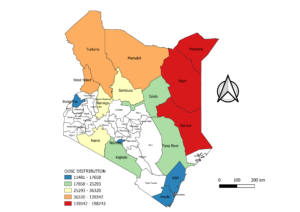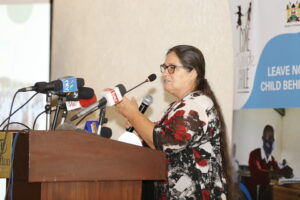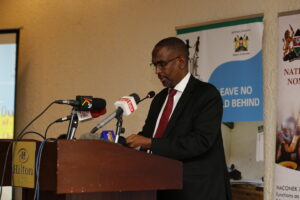PROJECT OVERVIEW
Kenya’s population is estimated at 47.6 million, according to 2019 census data. Some 18.3 million of these people are children of school age. But 10 out of 100 children aged 6 – 17 years have never been enrolled in school. While the attendance rates and out-of-school numbers are lower in the central areas of Kenya, regional disparities remain.
The school-age population has also increased from 16 million in 2010 to 18.3 million in 2019, representing an annual average growth of 2.5 percent. This has put pressure on the education sector by increasing classroom sizes and impacting the quality of learning. The Operation Come to School project is based on lessons learned from the previous incarnation of the project, implemented between 2015-19 in nine arid and semi-arid (ASAL) counties.
The project resulted in the successful enrolment and retention of 349o,460 children (48 percent girls) in school. Building on this success, the new expansion of the project aims at increasing the number of out-of-school children enrolled and retained in schools by a further 250,000 children (50 percent girls, 50 percent boys, and 5 percent children with disabilities) over the
next three years.

Duration:
3 Years (January 2021 – December 2023)
Coverage: ASAL counties Baringo, Garissa, Isiolo, Kajiado, Kilifi, Kwale, Mandera, Marsabit, Narok, Samburu, Tana River, Turkana, Wajir, West Pokot. Also Bungoma and urban
informal settlements in Nairobi.
Goal:
To provide equitable access to quality primary education for 250,000 (50% girls, 50% boys, and 5% children with disabilities) who are currently out-of-school children in Kenya.

CATEGORIES: OUT-OF-SCHOOL CHILDREN
The project is anchored on the “Five Dimensions of Exclusion Model” as defined by the Global Initiative on
Out-of-School Children, an operational manual developed by UNICEF and UNESCO-UIS. The targeted OOSC falls under four main categories that include:
(i) Children who do not have access to a school: these children will never attend unless they gain access. Lack of access is sometimes due to the lack of schools in catchment areas.
(ii) Children who have access to school but who are not enrolled: These children either never enter school or will enter school late because of an inability to afford school levies, the opportunity cost associated with school enrolment, cultural norms that are associated with gender stereotypes that see girls stay at home to perform chores, stigmatization, and discrimination of children with disabilities, and boys engaged in socio-economic activities.
(iii) Children who have access and have enrolled in school but who do not attend: sometimes due to the inability of guardians to afford school levies, preference for other religious forms of education such as madrassas, lack of teachers, and other learning resources which discourage parents from sending their children to schools.
(iv) Children who have dropped out of the education system: reasons are varied and include
the poverty leading to child labor and preference for employment over education by both parents
and learners, early pregnancies, drugs, and substance abuse, being an orphan and street life,
cultural practices such as child marriages, among other reasons.
KEY BARRIERS
In Kenya’s ASAL region: children don’t go to school due to cultural and social norms such as nomadic lifestyles, male education preference over females, poverty, gender stereotypes, household chores, early marriages, child labor, lack of water due to harsh climatic conditions, long-distance to schools, enrolment of early grade learners in religious education (duksi) over formal education among others. These problems are further amplified by crises and conflicts in ASAL areas.

The urban informal settlement: barriers to education include poverty and an inability to afford school levies (opportunity cost in enrolling children to school, for example, cost of uniforms, admission fees, reading and writing materials), child labor, preference by children to engage in income-generating activities, drug and substance abuse, early pregnancies and child marriages, children who drop out of school due to HIV. Either they are sick themselves or take care of sick family members. Inclusion: Children with disabilities face a unique set of barriers that include stigma and discrimination, lack of adequately trained teachers in mainstream schools, rigid curriculum, lack of appropriate training and learning materials, and lack of aides, unsupportive physical infrastructure.
KEY STRATEGIES
The proposed strategies will focus on effective interventions to address demand factors, e.g. back-to-school campaigns, community mobilization, and awareness-raising forums, conditional cash transfers, and supply and quality factors, e.g. teacher training on pedagogy, large classroom management, incentives for female teachers to support understaffed schools and remedial classes.
Key strategies developed to address the identified barriers faced by OOSC are:
• Continued community engagement and economic empowerment for OOSC enrolment and retention: spearheaded by community leaders, boards of management, and county education management teams to improve demand for education and inclusion using innovative support methods.
• Improve inclusive and gender-based access to a safe learning environment for OOSC: to provide a child-friendly environment that will improve the supply of education for OOSC and support retention in both ASAL and urban informal settlements.
• Strengthen the quality of teaching and learning in schools: through the implementation of competency-based curriculum, active engagement, and continuous professional development of teachers and capacity building of education stakeholders to improve quality of education for OOSC which will consequently, improve learning outcomes.
• Expand mentorship programs, life skills development for OOSC: to improve gender equity in the
provision of education for OOSC boys and girls’ empowerment.
• Active policy advocacy and engagement: through policy commitment by supporting the national
government in education policy development and evaluations. Continued support towards availability
of updated national data on OOSC and capacity building to government on curriculum reforms.
The program is implemented by NACONEK in conjunction with UNICEF and funded by the Educate a child foundation of Qatar.

